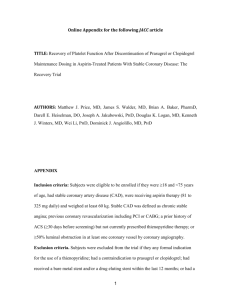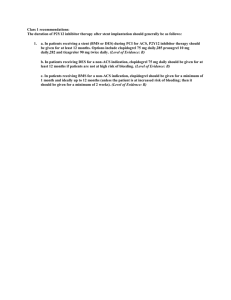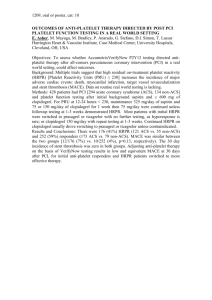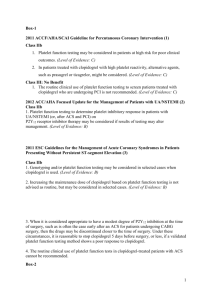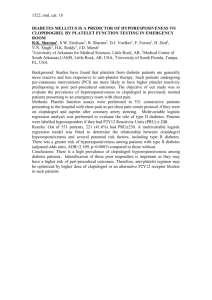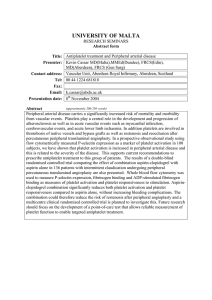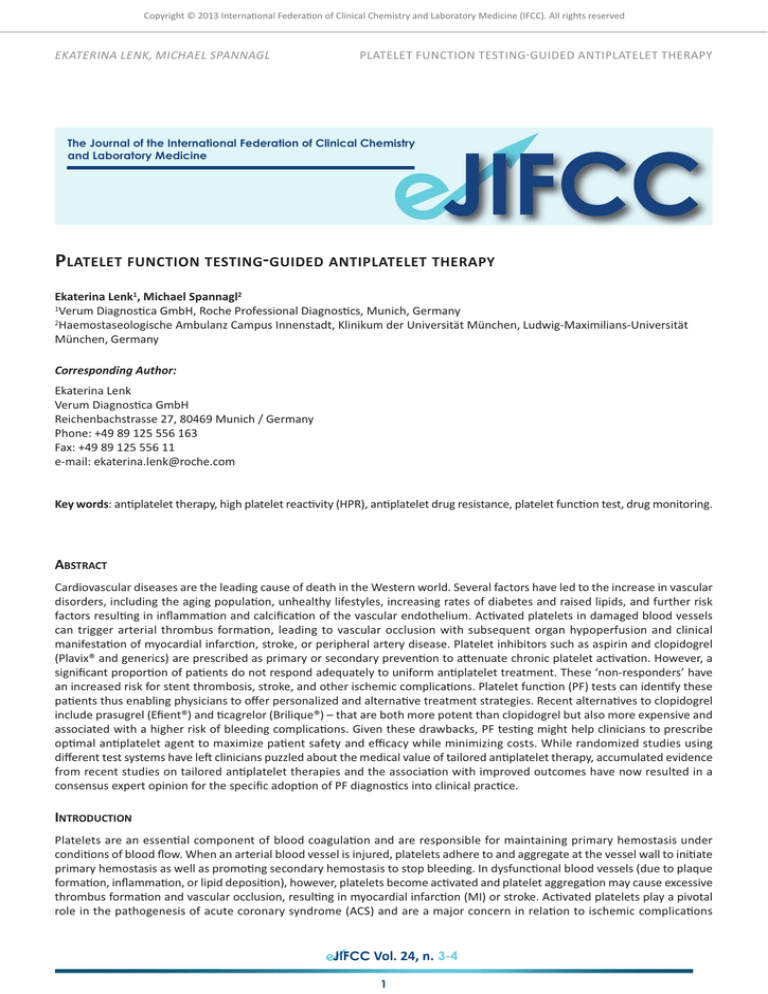
Copyright © 2013 International Federation of Clinical Chemistry and Laboratory Medicine (IFCC). All rights reserved
EKATERINA LENK, MICHAEL SPANNAGL
PLATELET FUNCTION TESTING-GUIDED ANTIPLATELET THERAPY
The Journal of the International Federation of Clinical Chemistry
and Laboratory Medicine
PLATELET FUNCTION TESTING-GUIDED ANTIPLATELET THERAPY
Ekaterina Lenk1, Michael Spannagl2
1Verum Diagnostica GmbH, Roche Professional Diagnostics, Munich, Germany
2Haemostaseologische Ambulanz Campus Innenstadt, Klinikum der Universität München, Ludwig-Maximilians-Universität
München, Germany
Corresponding Author:
Ekaterina Lenk
Verum Diagnostica GmbH
Reichenbachstrasse 27, 80469 Munich / Germany
Phone: +49 89 125 556 163
Fax: +49 89 125 556 11
e-mail: ekaterina.lenk@roche.com
Key words: antiplatelet therapy, high platelet reactivity (HPR), antiplatelet drug resistance, platelet function test, drug monitoring.
ABSTRACT
Cardiovascular diseases are the leading cause of death in the Western world. Several factors have led to the increase in vascular
disorders, including the aging population, unhealthy lifestyles, increasing rates of diabetes and raised lipids, and further risk
factors resulting in inflammation and calcification of the vascular endothelium. Activated platelets in damaged blood vessels
can trigger arterial thrombus formation, leading to vascular occlusion with subsequent organ hypoperfusion and clinical
manifestation of myocardial infarction, stroke, or peripheral artery disease. Platelet inhibitors such as aspirin and clopidogrel
(Plavix® and generics) are prescribed as primary or secondary prevention to attenuate chronic platelet activation. However, a
significant proportion of patients do not respond adequately to uniform antiplatelet treatment. These ‘non-responders’ have
an increased risk for stent thrombosis, stroke, and other ischemic complications. Platelet function (PF) tests can identify these
patients thus enabling physicians to offer personalized and alternative treatment strategies. Recent alternatives to clopidogrel
include prasugrel (Efient®) and ticagrelor (Brilique®) – that are both more potent than clopidogrel but also more expensive and
associated with a higher risk of bleeding complications. Given these drawbacks, PF testing might help clinicians to prescribe
optimal antiplatelet agent to maximize patient safety and efficacy while minimizing costs. While randomized studies using
different test systems have left clinicians puzzled about the medical value of tailored antiplatelet therapy, accumulated evidence
from recent studies on tailored antiplatelet therapies and the association with improved outcomes have now resulted in a
consensus expert opinion for the specific adoption of PF diagnostics into clinical practice.
INTRODUCTION
Platelets are an essential component of blood coagulation and are responsible for maintaining primary hemostasis under
conditions of blood flow. When an arterial blood vessel is injured, platelets adhere to and aggregate at the vessel wall to initiate
primary hemostasis as well as promoting secondary hemostasis to stop bleeding. In dysfunctional blood vessels (due to plaque
formation, inflammation, or lipid deposition), however, platelets become activated and platelet aggregation may cause excessive
thrombus formation and vascular occlusion, resulting in myocardial infarction (MI) or stroke. Activated platelets play a pivotal
role in the pathogenesis of acute coronary syndrome (ACS) and are a major concern in relation to ischemic complications
3-4
1
EKATERINA LENK, MICHAEL SPANNAGL
PLATELET FUNCTION TESTING-GUIDED ANTIPLATELET THERAPY
following percutaneous coronary intervention (PCI) [1, 2]. Even though stent thrombosis (ST) is a rare event, it is a severe or
fatal complication and is associated with high mortality rates [3, 4]. Dual antiplatelet therapy consisting of aspirin and a P2Y12inhibitor (clopidogrel, prasugrel, or ticagrelor) is state-of-the-art therapy in ACS patients undergoing PCI for prevention of ischemic
adverse events [5]. This therapy is maintained for 1 year in the majority of patients undergoing PCI. However, inter-individual
response to platelet inhibiting drugs has led to treatment failure in selected patients: up to 25% of patients respond inadequately
to clopidogrel [6] and around 10% have an inadequate response to aspirin [7]. The reason for this is multifactorial: genetic
factors, drug interactions, altered drug absorption, diet, age, lack of compliance, lifestyle, co-morbidities, and platelet turnover
may contribute to insufficient drug efficacy. The phenomenon of clopidogrel low responsiveness or ‘resistance’, which is also
termed high on-treatment platelet reactivity (HPR), has been associated with an increased risk of ischemic complications,
including ST [8–10]. Several publications and meta-analyses have also reported the increased incidence of arterial ischemia with
‘aspirin resistance’ [11–13].
PHAMACOKINETICS/PHARMACODYNAMICS OF CLOPIDOGREL, PRASUGREL, AND TICAGRELOR AND COMPARATIVE EFFICACY
One factor in the pathogenesis of clopidogrel low responsiveness is the complex biotransformation of this drug in the body.
Clopidogrel is a pro-drug and is converted to the active metabolite via several enzymatic steps. The cytochrome P450 (CYP)isoenzymes involved in the conversion of clopidogrel to its active metabolite have several polymorphisms. Variants of theses
enzymes with reduced activity (CYP2C19*2, ‘loss of function’ polymorphism) and also variants with increased activity
(CYP2C19*17, ‘gain of function’ polymorphism) have been described and linked to both clopidogrel responsiveness and to clinical
events [14–16]. More potent and less variable novel antiplatelet drugs have been developed and launched to market. Prasugrel
is also a thienopyridine pro-drug, which irreversibly blocks the P2Y12 receptor (adenosine diphosphate [ADP] receptor) but with
much higher potency compared with clopidogrel. The main difference between clopidogrel and prasugrel is that prasugrel is
more readily transformed to its active metabolite, fewer enzymes are involved, and the reaction time is much faster and less
variable. However, low responsiveness to prasugrel has also been reported [17].
Ticagrelor, in contrast to clopidogrel and prasugrel, is a direct-acting ADP antagonist and not a pro-drug. As a reversible ADP
receptor antagonist, it was expected that ticagrelor’s action would cease much faster than clopidogrel’s. However, the
ONSET/OFFSET trial showed that the platelet function (PF) inhibition of both agents was very similar, although ticagrelor showed
much higher potency compared with clopidogrel [18]. The drug approval trials TRITON-TIMI 38 [19] and PLATO [20] each
compared head-to-head the efficacy of prasugrel or ticagrelor versus standard care with clopidogrel. Both novel drugs showed
benefit with regard to ischemic events but at the same time were associated with an increased risk of bleeding. In fact, for
prasugrel an excess of life-threatening bleeding was observed [19]. Of particular note, a landmark analysis of the TRITON-TIMI
38 trial data showed that the bleeding risk for prasugrel was similar to clopidogrel during the first 3 days of treatment (in-hospital
bleeding events) but was significantly greater during Day 3 after the PCI procedure until the end of the study (i.e. post-hospital
discharge bleeding events). Thus, the excess of bleeding events observed with the use of prasugrel occurred predominantly
during the maintenance phase of treatment [21]. Moreover, most of the benefit seen with prasugrel versus clopidogrel treatment
in ACS patients with regard to thrombotic risk reduction was seen in the early and acute periods of treatment [19, 21]. As a
consequence, strategies to optimize P2Y12 receptor-directed antiplatelet treatment beyond the acute phase and during the
maintenance phase of treatment may significantly improve the outcome for ACS patients undergoing PCI. It is also important to
mention that both prasugrel and ticagrelor are significantly more costly than treatment with generic clopidogrel [22, 23]. An
individualized approach to treat clopidogrel low-responders with more potent drugs and to prescribe generic clopidogrel (which
is well tolerated and cheap) for patients without HPR might be a valid strategy to maintain the benefit for patients and reduce
healthcare costs. Therefore, it is of increasing interest to identify patients who are non-responders to antiplatelet drugs and to
tailor therapy to the most effective individual option.
PLATELET FUNCTION TESTING
There are several methods for platelet function testing (PFT), which differ with regard to the underlying detection principle,
agonists, and sample material used for testing. Light transmission aggregometry (LTA) is the historical gold standard for PF
analysis and monitoring the pharmacodynamic response to antiplatelet agents. This optical method is based on the change in
turbidity of the platelet-rich plasma after the addition of an agonist [24]. Even though this method is still widely used and has
shown significant clinical value, LTA is complex, time-consuming, and poorly standardized [25]. Flow cytometric analysis of the
phosphorylation state of the vasodilator stimulated phosphoprotein (VASP) is a very specific method for the evaluation of ADPreceptor inhibition. However, this technique requires a specialized laboratory environment and experienced staff and is thus
not suitable for routine clinical use. The VerifyNow® (Accumetrics, USA) device measures PF based on turbidimetric optical
detection of the aggregation of platelets with fibrinogen-coated plastic beads in whole blood. VerifyNow is a fully automated
3-4
2
EKATERINA LENK, MICHAEL SPANNAGL
PLATELET FUNCTION TESTING-GUIDED ANTIPLATELET THERAPY
and standardized point-of-care (POC) device. In the PFA-100 system, citrated whole blood is aspirated at high shear rates through
a capillary containing an aperture within a collagen-coated membrane [26]. Besides sensitivity to the antiplatelet drug’s effect,
the PFA system demonstrates high sensitivity for von Willebrand syndrome due to the measurement principle [27]. A further
method for PFT that is based on impedance aggregometry, the Multiplate® analyzer (Roche Diagnostics, Switzerland), is described
below. The characteristics of the most commonly used assays are also summarized in Table 1, which illustrates the wide variability
in the approach taken. Thus, it is not surprising that the results differ considerably from method to method [28]. It is, therefore,
important that every assay should be validated with regard to the relationship between the result provided and the association
with patient outcome. If this validation of assay-specific predictability is not available, the results should be interpreted with
caution, and be based on the physician’s experience and in line with the current guideline recommendations.
In order to translate laboratory findings into clinical benefits, it is paramount that standardized PFT methods which are
comparable across centers and have high clinical predictivity to determine patient risk for thrombosis or bleeding are utilized.
Evidence is required for the PFT result being a modifiable risk factor, i.e. the drug intervention based on the test result has to
translate into superior clinical outcomes. According to the consensus document on the definition of HPR to ADP the Multiplate
analyzer demonstrated the best predictability of ischemic events with an odds ratio of 12 (12 times increased risk for clopidogrel
low-responders for early ST), while other studies using, for example, the VerifyNow system or LTA showed an odds ratio of only
2–4 and 2–6, respectively [10, 28, 30]. A large meta-analysis in 4213 patients on the efficacy and safety of intensified antiplatelet
therapy on the basis of platelet reactivity testing in patients after PCI concluded that for high-risk patients “intensifying
antiplatelet therapy on the basis of platelet reactivity testing reduces cardiovascular mortality and ST after PCI” [31]. Several
registry studies confirmed this finding using the Multiplate ADPtest [17, 32, 33]. In contrast, randomized studies (ARCTIC [34],
GRAVITAS [35] and TRIGGER-PCI [36]) using the VerifyNow device failed to confirm the concept of improving patient benefit
based on tailored anti-platelet therapy. There are different reasons which led to the negative results of these studies, in particular
the studies mostly recruited patients with stable coronary artery disease patients who exhibited a low-to-intermediate risk for
recurrent thromboembolic complications. Furthermore, the studies made little use of switching patients to more potent drugs
in the case of clopidogrel low-response, a relatively high proportion of patients were defined as low-responders (>40% in
GRAVITAS), and non-PFT-related study endpoints were chosen in ARCTIC (periprocedual MI), which allowed complicated drug
treatment protocols according to the physicians discretion [37]. In fact, in the open-label ARCTIC trial involving 2440 patients,
antiplatelet therapy was intensified in the monitoring arm with either an additional bolus plus intensified maintenance dose of
clopidogrel (80.2%), by switching to prasugrel (only 3.3%), by increasing the dose of aspirin, or by additional treatment with
glycoprotein IIb/IIIa inhibitors during PCI [34]. It is important to remember that neither prasugrel nor ticagrelor were available
at the time of the GRAVITAS trial and a strategy of single re-loading and doubling the maintenance dose of clopidogrel versus
standard dose clopidogrel has been shown to be non-efficacious in 2200 patients with HPR [35]. The fact that HPR resolved over
time in 40% of patients in the guided group of the GRAVITAS trial might be a further possible explanation for the negative
Table 1
Comparison between the most commonly used platelet function assays (modified from [27]).
Method
Laboratory
based
Test
Medium
Detection
Light transmission
aggregometry (LTA)
Platelet-rich
plasma (PRP)
Reduction of optical density • Instrument adjustment
after stimulation in PRP
possible
• Good predictivity
• Long experience
• Time-consuming
• Complex sample preparation
• No standardization
Vasodilator-stimulated
phosphoprotein (VASP) assay
Whole blood
Flow cytometric detection
of VASP phosphorylation
• Whole blood assay
• Longer sample storage
• P2Y12 receptor specific
• Very time-consuming
• Complex sample preparation
• Need of flow cytometer
Multiplate analyzer
(multiple electrode
aggregometry [MEA]
Coating of two electrode
pairs by platelets
• Whole blood assay
• Simple and rapid
• Standardized
procedures
• Semi-automated
(requires pipetting)
• Rapid processing of samples
necessary
VerifyNow
Platelet-mediated
aggregation of fibrinogencoated polystyrene beads
• No assay adjustment
possible
• Expensive cartridges
Closure of an aperture of a
collagen-coated membrane
• No assay adjustment possible
• Dependent on hematocrit
and von Willebrand factor
• Limited experience and study
results with P2Y12-inhibitors
Near patient
Whole blood
PFA-100
Advantages
3-4
3
Disadvantages
EKATERINA LENK, MICHAEL SPANNAGL
PLATELET FUNCTION TESTING-GUIDED ANTIPLATELET THERAPY
outcome of the study [38]. Furthermore, the pre-specified cut-off for the VerifyNow test of 230 P2Y12 reaction units (PRU) that
was used in GRAVITAS to identify clopidogrel low-responders defined a high proportion of patients with HPR who did not exhibit
any greater thrombotic risk compared to the control cohort of clopidogrel normal responders in the observational substudy.
According to a post hoc analysis of the GRAVITAS results, a lower cut-off for the definition of HPR of 208 PRU was associated
with a lower risk for cardiovascular events [38]. This cut-off was used in the Testing Platelet Reactivity in Patients Undergoing
Elective Stent Placement on Clopidogrel to Guide Alternative Therapy With Prasugrel (TRIGGER-PCI) trial which randomized
subjects with HPR on clopidogrel after successful PCI [36]. However, this study was halted prematurely by the steering committee
after randomization of 423 patients (of the planned 2150) because of a lower than expected clinical event rate. Therefore, it is
not surprising that these studies on personalized antiplatelet therapy approaches failed to confirm a significant benefit. In
contrast, several studies involving more than 2500 patients did show the proven benefit of individualized treatment guided by
the Multiplate analyzer [32, 33, 39]. In fact, a switch from clopidogrel to prasugrel significantly improved clinical outcome in
patients with HPR in the MADONNA study [32]. According to a cut-off value of 47 U for the Multiplate ADPtest, the percentage
of clopidogrel low-responders is about 20–25% [8, 33]. The results of the ISAR -HPR registry from Munich University (Germany)
which included 999 high-risk ACS patients with HPR could demonstrate a significant reduction in the risk of death or ST
(HRadj=0.18, 95% confidence interval (CI)=0.07–0.50; P=0.0008, Cox model) in the Multiplate tailored cohort receiving prasugrel
or repeated loading doses of clopidogrel versus the control cohort treated with conventional clopidogrel therapy [39].
In the Pécs registry from the Heart Center Balatonfüred (Pécs, Hungary), 741 consecutive high-risk ACS patients undergoing PCI
were enrolled, comprising almost 50% ST segment elevation myocardial infarction and 5% cardiogenic shock patients with an
overall mortality of 8.1% and an ST rate of 5.3% during 1 year follow-up. The authors concluded that tailoring antiplatelet
treatment based on the Multiplate result and “switching ACS patients with HPR to prasugrel reduces thrombotic and bleeding
events to a level similar to those without HPR…, while high-dose clopidogrel resulted in higher risk for both thrombotic and
bleeding complications” [33]. These findings clearly demonstrate the clinical utility of PFT with Multiplate for guided antiplatelet
treatment with intensification of P2Y12-receptor inhibition via switch to prasugrel in clopidogrel low-responders.
In general, randomized studies testing the value of PF-guided antiplatelet treatment regimens have been conducted focusing
on the acute phase to guide therapy. Thus, it is not known at present if ACS patients may benefit from a personalized antiplatelet
treatment regimen with potent third-generation ADP receptor antagonists beyond the acute phase. In addition to the possible
benefits of individualized antiplatelet treatment on the clinical outcome of ACS patients, the economic impact and the costsaving potential of such a treatment regimen remains to be determined. Cost-effectiveness analyses in such scenarios must
focus on both the cost savings driven by the use of generic clopidogrel and the costs associated with adverse events (bleeding
and thrombotic complications).
Recently, Straub et al. described a model-based analysis of cost-effectiveness of PFT with Multiplate [40]. The aim of this modelbased health economic analysis was to use the available evidence to assess the clinical and economic impact of a personalized
antiplatelet treatment regimen based on PFT with the Multiplate analyzer compared with the unrestricted use of prasugrel and
ticagrelor in ACS patients undergoing PCI. According to this model which utilizes peer-reviewed, published data for the model
analysis, PFT-guided therapy for selection of P2Y12-inhibitors in ACS patients undergoing PCI appeared to have fewer adverse
events than general treatment with clopidogrel and may be more cost-effective than prasugrel and ticagrelor therapy. However,
these results require further investigation and confirmation in large randomized controlled studies. At present, a randomized
trial has not been conducted to directly compare the PFT-guided selection of clopidogrel or novel P2Y12-inhibitiors in ACS
patients with either generic clopidogrel or with prasugrel/ticagrelor. This gap may be overcome by a recently announced study
entitled Testing Responsiveness to Platelet Inhibition on Chronic Antiplatelet Treatment for Acute Coronary Syndromes
(TROPICAL-ACS) [41]. TROPICAL-ACS is an investigator-initiated, multicenter study designed to evaluate the benefit of
personalized antiplatelet therapy in ACS patients treated with PCI. The objective of TROPICAL-ACS is to determine whether a
PFT-guided approach that employs the Multiplate ADPtest with a controlled switch from prasugrel to clopidogrel antiplatelet
maintenance treatment is non-inferior to standard 12-month treatment with prasugrel with regards to a combined ischemic
and bleeding event. It will address both the clinical and economic impact of an individualized P2Y12 receptor-directed antiplatelet
treatment in ACS patients undergoing PCI. If the TROPICAL-ACS study meets its primary endpoint, the tailored antiplatelet
therapy approach will carry a significant cost-saving potential alongside the benefit to patients, with generic clopidogrel being
up to 20 times less costly than prasugrel or ticagrelor. This would translate into cost savings of up to 1500 US$ per patient for
annual drug therapy, based on US drug pricing [22, 23].
The expert opinion of the European Society of Cardiology Working Group on Thrombosis regarding the role of PFT in patients
undergoing coronary stenting was published in the European Heart Journal in October 2013 and emphasized the utility of PF
diagnostics in clinical practice. The paper states “based on the currently available evidence, the recommended assays for
3-4
4
EKATERINA LENK, MICHAEL SPANNAGL
PLATELET FUNCTION TESTING-GUIDED ANTIPLATELET THERAPY
monitoring platelet inhibition during P2Y12-inhibitors are the VerifyNow P2Y12 assay, the Multiplate device with the ADP kit
and the VASP assay”. LTA “is only recommended when no standardized assays are available” [25]. In addition, the US Working
Group published a Consensus and Update on the Definition of On-Treatment Platelet Reactivity stating that, based on available
evidence, “a risk algorithm that includes PFT along with biomarker testing and clinical factors may improve risk prediction and
facilitate personalization of antiplatelet therapy” [42].
MONITORING OF PLATELET FUNCTION IN MAJOR SURGERY
The use of antiplatelet therapy is continuing to expand due to the increasing prevalence of cardiovascular disease. Patients
taking antiplatelet drugs who are scheduled for major surgery present clinicians with the challenge of balancing the risk of
thrombotic complications (if antiplatelet drugs are stopped before surgery), with the problems of excessive bleeding when
surgery is performed in the absence of adequate PF, which impairs patient prognosis and increases the cost of hemostatic
management.
Current guidelines recommend stopping antiplatelet drugs 3 to 7 days before surgery [43–45]. This can mean an additional cost
of in-hospital patient care while waiting for surgery. However, it is important to remember that approximately 20% of patients do
not respond adequately to clopidogrel initially [8, 9, 46, 47]. The Society of Thoracic Surgeons Clinical Practice Guidelines (updated
in 2012) states “for patients on dual antiplatelet therapy, it is reasonable to make decisions about surgical delay based on tests of
platelet inhibition rather than arbitrary use of a specified period of surgical delay” [43]. Preoperative PFT facilitates the
identification of those patients who have recovered sufficient PF to allow surgery to be scheduled without unnecessary delay.
Several clinical studies have shown that the aggregation values assessed with Multiplate correlate with the risk of bleeding and
transfusions in patients who are pre-treated with dual antiplatelet therapy [48–52]. Ranucci et al. suggested a cut-off of 31 U for
the Multiplate ADPtest to support a clinical decision to either postpone elective surgery if the patient’s PF is below this value, or
if there is an urgent requirement to perform surgery, to ensure adequate precautions and appropriate therapeutic consequences
(e.g. ensure availability of platelet concentrates at the blood bank, selection of a less traumatic surgical approach with good
visibility, and less aggressive hemodilution), because aggregation <31 U was associated with significantly increased bleeding risk
[48]. According to prospectively validated algorithms based on POC coagulation testing in surgical patients, Multiplate analysis
can be used for treatment stratification in bleeding patients. In this setting, when normal aggregation is found by underlying
bleeding, platelet transfusion is considered less efficient to improve the bleeding situation. In contrast, in patients who bleed and
show inhibited PF, this is a sign that administration of platelets or desmopressin could improve the clinical situation [53, 54].
Weber et al. demonstrated that the hemostatic therapy algorithm guided by POC testing via Multiplate and thromboelastometry
not only reduced patient exposure to allogenic blood products and decreased number of transfused units of packed erythrocytes
but also lowered fresh frozen plasma and platelet concentrate usage. Furthermore, a POC-guided algorithm significantly improved
clinical outcome and provided significant cost benefits compared with the standard treatment [53].
THE MULTIPLATE® ANALYZER
The Multiplate analyzer was introduced in 2005 [55] and is an advance on impedance aggregometry, which was presented by
Cardinal and Flower in 1979 [56]. It assesses PF in whole blood by the attachment of thrombocytes onto metal electrodes,
leading to a change in the electrical conductivity (or impedance), which is continuously recorded. The Multiplate analyzer
provides five channels for parallel determinations as well as automatic analysis, calibration, and documentation using an
integrated computer system. The disposable measurement cell incorporates a magnetic stirrer as well as two independent
electrode pairs. Therefore, a double determination is performed during each test. Multiplate analysis allows the assessment of
platelet aggregation using collagen, arachidonic acid, ADP, TRAP-6, and ristocetin stimulation. Typically, 300 µL of whole blood
are added to 300 µL of isotonic saline and then analyzed.
In impedance aggregometry (as applied by the Multiplate system) the platelets have to firmly adhere to sensors, comprised of
metal electrodes, in order to trigger a signal reaction, a mechanism similar to the in vivo adhesion and aggregation of platelets
on a metallic stent surface or at the vessel lesion. By contrast, a pre-existing loose aggregation in solution can lead to the
reduction of turbidity in classical LTA.
CONCLUSIONS
Monitoring a patient’s individual response to different antiplatelet drugs can contribute to providing optimal treatment for patients
at risk of arterial thrombosis. PFT represents a tangible example of personalized healthcare and ongoing randomized clinical
studies will further elucidate the medical value of this biomarker. PFT has the potential to assist clinicians in determining an
individual patient’s risk of arterial thrombosis and bleeding and support informed decisions relating to the needs of each patient.
3-4
5
EKATERINA LENK, MICHAEL SPANNAGL
PLATELET FUNCTION TESTING-GUIDED ANTIPLATELET THERAPY
References
1.
2.
3.
4.
5.
6.
7.
8.
9.
10.
11.
12.
13.
14.
15.
16.
17.
18.
19.
20.
21.
22.
23.
24.
25.
26.
27.
28.
29.
30.
Fitzgerald DJ, Roy L, Catella F, FitzGerald GA. Platelet activation in unstable coronary disease. N Engl J Med. 1986; 315(16):983–989.
Fuster V, Badimon L, Badimon JJ, Chesebro JH. The pathogenesis of coronary artery disease and the acute coronary syndromes (1). N
Engl J Med. 1992; 326(4):242–250.
Cutlip DE, Baim DS, Ho KK, Popma JJ, Lansky AJ, Cohen DJ, et al. Stent thrombosis in the modern era: a pooled analysis of multicenter
coronary stent clinical trials. Circulation. 2001; 103(15):1967–1971.
Kimura T, Morimoto T, Kozuma K, Honda Y, Kume T, Aizawa T, et al. Comparisons of baseline demographics, clinical presentation, and
long-term outcome among patients with early, late, and very late stent thrombosis of sirolimus-eluting stents: Observations from the
Registry of Stent Thrombosis for Review and Reevaluation (RESTART). Circulation. 2010; 122(1):52–61.
Hamm CW, Bassand JP, Agewall S, Bax J, Boersma E, Bueno H, et al. ESC Guidelines for the management of acute coronary syndromes in
patients presenting without persistent ST-segment elevation: The Task Force for the management of acute coronary syndromes (ACS) in
patients presenting without persistent ST-segment elevation of the European Society of Cardiology (ESC). Eur Heart J. 2011; 32(23):
2999–3054.
Giorgi MA, Di Girolamo G, González CD. Nonresponders to clopidogrel: pharmacokinetics and interactions involved. Expert Opin
Pharmacother. 2010; 11(14): 2391–2403.
Gum PA, Kottke-Marchant K, Poggio ED, Gurm H, Welsh PA, Brooks L, et al., Profile and prevalence of aspirin resistance in patients with
cardiovascular disease. Am J Cardiol. 2001; 88(3):230–235.
Sibbing D, Braun S, Morath T, Mehilli J, Vogt W, Schömig A, et al. Platelet reactivity after clopidogrel treatment assessed with point-ofcare analysis and early drug-eluting stent thrombosis. J Am Coll Cardiol. 2009; 53(10):849–856.
Sibbing D, Morath T, Braun S, Stegherr J, Mehilli J, Vogt W, et al. Clopidogrel response status assessed with Multiplate point-of-care
analysis and the incidence and timing of stent thrombosis over six months following coronary stenting. Thromb Haemost. 2010;
103(1):151–159.
Bonello L, Tantry US, Marcucci R, Blindt R, Angiolillo DJ, Becker R, et al. Consensus and future directions on the definition of high ontreatment platelet reactivity to adenosine diphosphate. J Am Coll Cardiol. 2010; 56(12):919–933.
Gum PA, Kottke-Marchant K, Welsh PA, White J, Topol EJ. A prospective, blinded determination of the natural history of aspirin resistance
among stable patients with cardiovascular disease. J Am Coll Cardiol. 2003; 41(6):961–965.
Krasopoulos G, Brister SJ, Beattie WS, Buchanan MR. Aspirin "resistance" and risk of cardiovascular morbidity: systematic review and
meta-analysis. BMJ. 2008; 336(7637): 195–198.
Snoep JD, Hovens MM, Eikenboom JC, van der Bom JG, Huisman MV. Association of laboratory-defined aspirin resistance with a higher
risk of recurrent cardiovascular events: a systematic review and meta-analysis. Arch Intern Med. 2007; 167(15):1593–1599.
Sibbing D, Koch W, Gebhard D, Schuster T, Braun S, Stegherr J, et al. Cytochrome 2C19*17 allelic variant, platelet aggregation, bleeding
events, and stent thrombosis in clopidogrel-treated patients with coronary stent placement. Circulation. 2010; 121(4): 512–518.
Sibbing D, Stegherr J, Latz W, Koch W, Mehilli J, Dörrler K, et al. Cytochrome P450 2C19 loss-of-function polymorphism and stent
thrombosis following percutaneous coronary intervention. Eur Heart J. 2009; 30(8):916–922.
Yende S, Wunderink RG. Effect of clopidogrel on bleeding after coronary artery bypass surgery. Crit Care Med. 2001; 29(12):2271–2275.
Sibbing D, Mayer K, Bernlochner I, Morath T, Jaitner J, Haase U, et al. Platelet Function Testing guided use of prasugrel in patients with
high on-clopidogrel treatment platelet reactivity reduces the risk of early stent thrombosis. J Am Coll Cardiol. 2012; 59(13s1):E265–E265.
Gurbel PA, Bliden KP, Butler K, Tantry US, Gesheff T, Wei C, et al. Randomized double-blind assessment of the ONSET and OFFSET of the
antiplatelet effects of ticagrelor versus clopidogrel in patients with stable coronary artery disease: the ONSET/OFFSET study. Circulation.
2009; 120(25):2577–2585.
Wiviott SD, Braunwald E, McCabe CH, Montalescot G, Ruzyllo W, Gottlieb S, et al. Prasugrel versus clopidogrel in patients with acute
coronary syndromes. N Engl J Med. 2007; 357(20):2001–2015.
Wallentin L, Becker RC, Budaj A, Cannon CP, Emanuelsson H, Held C, et al. Ticagrelor versus clopidogrel in patients with acute coronary
syndromes. N Engl J Med. 2009; 361(11):1045–1057.
Antman EM, Wiviott SD, Murphy SA, Voitk J, Hasin Y, Widimsky P, et al. Early and late benefits of prasugrel in patients with acute coronary
syndromes undergoing percutaneous coronary intervention: a TRITON-TIMI 38 (TRial to Assess Improvement in Therapeutic Outcomes
by Optimizing Platelet InhibitioN with Prasugrel-Thrombolysis In Myocardial Infarction) analysis. J Am Coll Cardiol. 2008; 51(21):2028–
2033.
http://www.goodrx.com (Last accessed August 2013).
http://www.healthwarehouse.com (Last accessed August 2013).
Born GV. Aggregation of blood platelets by adenosine diphosphate and its reversal. Nature 1962; 194:927–929.
Aradi D, Storey RF, Komócsi A, Trenk D, Gulba D, Kiss RG, et al. Expert position paper on the role of platelet function testing in patients
undergoing percutaneous coronary intervention. Eur Heart J. 2013 (epub ahead of print).
Kundu SK, Heilmann EJ, Sio R, Garcia C, Ostgaard RA. Characterization of an in vitro platelet function analyzer, PFA-100(TM). Clin Appl
Thromb Hemost. 1996; 2(4):241–249.
Favaloro EJ. Clinical utility of the PFA-100. Semin Thromb Hemost. 2008; 34(8):709–733.
Breet NJ, van Werkum JW, Bouman HJ, Kelder JC, Ruven HJ, Bal ET, et al. Comparison of platelet function tests in predicting clinical
outcome in patients undergoing coronary stent implantation. JAMA. 2010; 303(8):754–762.
Sibbing D, Spannagl M. Direct oral anticoagulants and antiplatelet agents. Clinical relevance and options for laboratory testing.
Hamostaseologie. 2013; 34(1) (epub ahead of print).
Stone GW, Witzenbichler B, Weisz G, Rinaldi MJ, Neumann FJ, Metzger DC, et al. Platelet reactivity and clinical outcomes after coronary
3-4
6
EKATERINA LENK, MICHAEL SPANNAGL
PLATELET FUNCTION TESTING-GUIDED ANTIPLATELET THERAPY
artery implantation of drug-eluting stents (ADAPT-DES): a prospective multicentre registry study. Lancet. 2013; 382(9892):614–623.
31. Aradi D, Komócsi A, Price MJ, Cuisset T, Ari H, Hazarbasanov D, et al. Efficacy and safety of intensified antiplatelet therapy on the basis
of platelet reactivity testing in patients after percutaneous coronary intervention: systematic review and meta-analysis. Int J Cardiol.
2013; 167(5):2140–2148.
32. Siller-Matula JM, Francesconi M, Dechant C, Jilma B, Maurer G, Delle-Karth G, et al. Personalized antiplatelet treatment after percutaneous
coronary intervention: the MADONNA study. Int J Cardiol. 2013; 167(5):2018–2023.
33. Aradi D et al. Optimizing P2Y12-receptor inhibition in acute coronary syndrome patients based on platelet function testing: impact of
prasugrel and high-dose clopidogrel. J Am Coll Cardiol. 2014. In press.
34. Collet JP, Cuisset T, Rangé G, Cayla G, Elhadad S, Pouillot C, et al. Bedside monitoring to adjust antiplatelet therapy for coronary stenting.
N Engl J Med. 2012; 367(22):2100–2109.
35. Price MJ, Berger PB, Teirstein PS, Tanguay JF, Angiolillo DJ, Spriggs D, et al. Standard- vs high-dose clopidogrel based on platelet function
testing after percutaneous coronary intervention: the GRAVITAS randomized trial. JAMA. 2011; 305(11):1097–1105.
36. Trenk D, Stone GW, Gawaz M, Kastrati A, Angiolillo DJ, Müller U, et al. A randomized trial of prasugrel versus clopidogrel in patients with
high platelet reactivity on clopidogrel after elective percutaneous coronary intervention with implantation of drug-eluting stents: results
of the TRIGGER-PCI (Testing Platelet Reactivity In Patients Undergoing Elective Stent Placement on Clopidogrel to Guide Alternative
Therapy With Prasugrel) study. J Am Coll Cardiol. 2012; 59(24):2159–2164.
37. Siller-Matula JM, Jilma B. Why have studies of tailored anti-platelet therapy failed so far? Thromb Haemost. 2013; 110(4):628–631.
38. Trenk D, Zolk O, Fromm MF, Neumann FJ, Hochholzer W. Personalizing antiplatelet therapy with clopidogrel. Clin Pharmacol Ther. 2012;
92(4):476–485.
39. Mayer K, Schulz S, Bernlochner I, Morath T, Braun S, Hausleiter J. The impact of personalized antiplatelet treatment on early adverse
events in PCI-treated patients with high on-clopidogrel platelet reactivity: results of the ISAR-HPR registry. Eur Heart J. 2013; 34(Abstract
Supplement):888–889; P4872.
40. Straub N, Beivers A, Lenk E, Aradi D, Sibbing D, et al. A model-based analysis of the clinical and economic impact of personalising P2Y12receptor inhibition with platelet function testing in acute coronary syndrome patients. Thromb Haemost. 2013; 111(2) (epub ahead of
print).
41. http://clinicaltrials.gov/. Testing Responsiveness to Platelet Inhibition on Chronic Antiplatelet Treatment For Acute Coronary Syndromes
Trial (TROPICAL-ACS): NCT01959451. 2013.
42. Tantry US, Bonello L, Aradi D, Price MJ, Jeong YH, Angiolillo DJ, et al. Consensus and Update on the Definition of On-Treatment Platelet
Reactivity to ADP Associated with Ischemia and Bleeding. J Am Coll Cardiol. 2013; 62(24):2261–2273.
43. Ferraris VA, Brown JR, Despotis GJ, Hammon JW, Reece TB, Saha SP, et al. 2011 Update to The Society of Thoracic Surgeons and the
Society of Cardiovascular Anesthesiologists Blood Conservation Clinical Practice Guidelines. Ann Thoracic Surg. 2011; 91(3):944–982.
44. Hillis LD, Smith PK, Anderson JL, Bittl JA, Bridges CR, Byrne JG, et al. 2011 ACCF/AHA Guideline for Coronary Artery Bypass Graft Surgery
A Report of the American College of Cardiology Foundation/American Heart Association Task Force on Practice Guidelines Developed in
Collaboration With the American Association for Thoracic Surgery, Society of Cardiovascular Anesthesiologists, and Society of Thoracic
Surgeons. J Am Coll Cardiol. 2011; 58(24):E123–E210.
45. Fitchett D, Mazer CD, Eikelboom J, Verma S. Antiplatelet therapy and cardiac surgery: review of recent evidence and clinical implications.
Can J Cardiol. 2013; 29(9):1042–1047.
46. Schulz S, Sibbing D, Braun S, Morath T, Mehilli J, Massberg S, et al. Platelet response to clopidogrel and restenosis in patients treated
predominantly with drug-eluting stents. Am Heart J. 2010; 160(2):355–361.
47. Siller-Matula JM, Christ G, Lang IM, Delle-Karth G, Huber K, Jilma B. Multiple electrode aggregometry predicts stent thrombosis better
than the vasodilator-stimulated phosphoprotein phosphorylation assay. J Thromb Haemost. 2010; 8(2):351–359.
48. Ranucci M, Baryshnikova E, Soro G, Ballotta A, De Benedetti D, Conti D, et al. Multiple electrode whole-blood aggregometry and bleeding
in cardiac surgery patients receiving thienopyridines. Ann Thoracic Surg. 2011; 91(1):123–129.
49. Reece MJ, Klein AA, Salviz EA, Hastings A, Ashworth A, Freeman C, et al. Near-patient platelet function testing in patients undergoing
coronary artery surgery: a pilot study. Anaesthesia. 2011; 66(2):97–103.
50. Rahe-Meyer N, Winterhalter M, Boden A, Froemke C, Piepenbrock S, Calatzis A, Solomon C. Platelet concentrates transfusion in cardiac
surgery and platelet function assessment by multiple electrode aggregometry. Acta Anaesthesiol Scand. 2009; 53(2):168–175.
51. Rahe-Meyer N, Winterhalter M, Hartmann J, Pattison A, Hecker H, Calatzis A, Solomon C. An evaluation of cyclooxygenase-1 inhibition
before coronary artery surgery: aggregometry versus patient self-reporting. Anesth Analg. 2008; 107(6):1791–1797.
52. Wang H, Leff J, Nair S, Shore-Lesserson L. Use of multiple electrode aggregometry (MEA) in predicting postoperative bleeding and
transfusion requirements after cardiopulmonary bypass surgery, a prospective observational study. Anesth Analg. 2012; 114(suppl):1–
94.
53. Weber CF, Görlinger K, Meininger D, Herrmann E, Bingold T, Moritz A, et al. Point-of-care testing a prospective, randomized clinical trial
of efficacy in coagulopathic cardiac surgery patients. Anesthesiology. 2012; 117(3):531–547.
54. Görlinger K, Dirkmann D, Hanke AA, Kamler M, Kottenberg E, Thielmann M, et al. First-line Therapy with Coagulation Factor Concentrates
Combined with Point-of-Care Coagulation Testing Is Associated with Decreased Allogeneic Blood Transfusion in Cardiovascular Surgery
A Retrospective, Single-center Cohort Study. Anesthesiology. 2011; 115(6):1179–1191.
55. Calatzis A, Wittwer M, Krueger B. A new approach to platelet function analysis in whole blood - the Multiplate analyzer. Platelets. 2004;
15(8):479–517.
56. Cardinal DC, Flower RJ. The electronic aggregometer: a novel device for assessing platelet behavior in blood. J Pharmacol Methods. 1980;
3(2):135–158.
3-4
7

